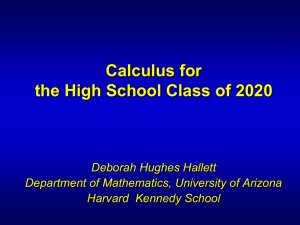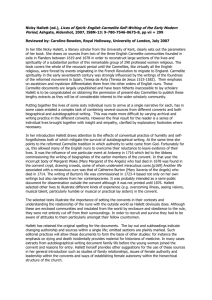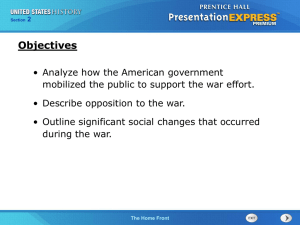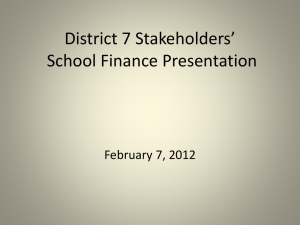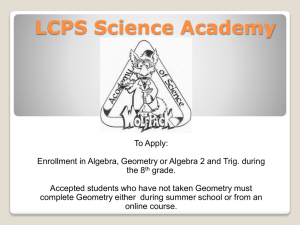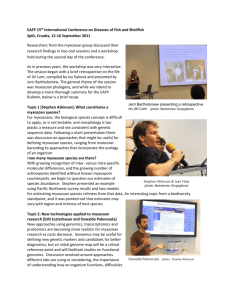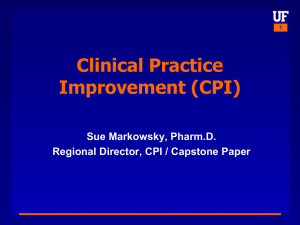DHH_InserviceBanff
advertisement
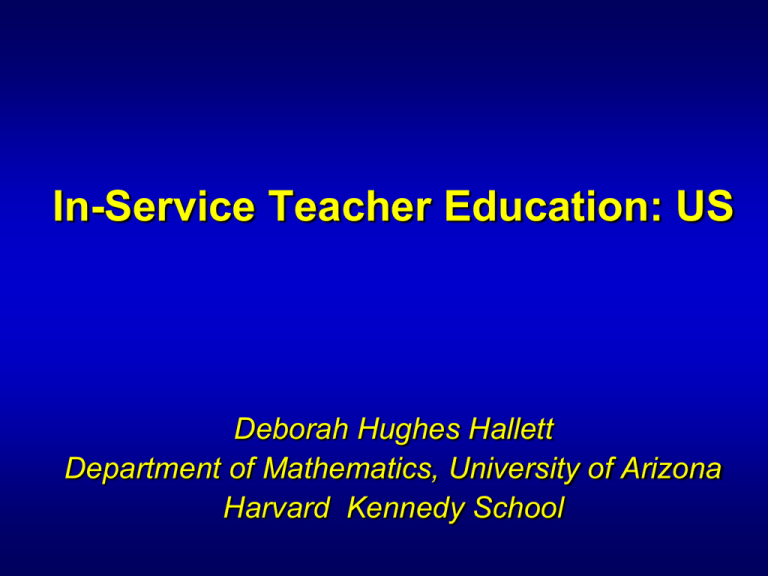
In-Service Teacher Education: US Deborah Hughes Hallett Department of Mathematics, University of Arizona Harvard Kennedy School The US Context • Teachers are (too) busy keeping up with everyday requirements (often non-academic) • Curriculum is often not the teachers’ own; they often work largely from a prescribed text • During the school year, in-service sessions that are immediately useful to teachers have the most impact What Works Best? • Providing copies of materials that teachers can easily copy or adapt • Illustrating pedagogical techniques that can be used in a classroom right away (don’t need equipment, further training, etc) • Exhibiting support for policies that teachers want to persuade administrators or parents • Answers to “landscape questions”: How topics fit together, where mathematics is applied http://www.teachersasscholars.org/ Some Organizations offering In-Service http://crr.math.arizona.edu/ Organizations • Organizations may be private NGOs (Teachers as Scholars) or – Paid for by school districts or grants • Based at a university (CRR and IM&E) – Offer in-service teacher education to schools that want it or pay for it; not mandated • States and school districts may also have their own teacher education staff – May offer mandatory education sessions conducted either by their own staff or by outsides Scheduling • During school year: • One or two day sessions, or • 2 hours a night once a week for several weeks • Often not paid but usually give PDPs (professional development points, ) • During summers: • One day to one month, more hours per day • Often give college credit or count toward master’s degree Types of Problems and Activities Teachers Have Found Useful, and Why First, what is the mindset of the students? Student Beliefs About Mathematics: Harvard Undergraduates (about 1990) Answer choices for each question: Disagree 1 2 3 4 5 Agree • A well-written problem makes it clear what method to use to solve it – Calculus students: 4.1, precalculus: 4.6 • If you can’t do a homework problem, you should be able to find a worked example in the text that will show you how – Calculus students: 4.1, precalculus: 4.7 • Review problems should have the section of the text they come from listed after them in parentheses – Calculus students: 4.2, precalculus: 4.8 Calculus Rates and Concavity From Precalculus bt Connally, et al, Wiley2011 Calculus: Derivatives From Calculus by Hughes Hallett, Gleason, McCallum, et al, Wiley 2013. Application to Medicine: Exponential Decay & Separable Des David Sloane MD (Harvard Medical School) Distance-Velocity Functions: Integrals-Derivatives From TAS Seminar, Deb Hughes Hallett Scatter Plots (middle school) Famous Personalities SCATTER PLOT •Estimated age •Actual age Guess how old? Taylor Lautner How Old? • Miley Cyrus How old? • Barrack Obama How old? • Stefani Germanotta • a.k.a Lady Gaga Actual Ages… Graphs and Algebra (middle and high school) Basic: Functions and Graphs From Functions Modeling Change by Connally, Hughes Hallett, et al Common Core State Standards: Functions and Interpretation From Algebra by McCallum, Connally, Hughes Hallett, et al Common Core State Standards: Functions and Interpretation From Algebra by McCallum, Connally, Hughes Hallett, et al Structure from the Viewpoint of Other Disciplines: Economics and Biology Economists and Algebraic Structure: Consumer Price Index (CPI) Data is as follows: CPI, with 1982-84 def ined to be 100 250 y = 8.3132e0.0326x R² = 0.9185 CPI 200 150 100 50 0 0 20 40 60 Years since 1913 80 100 Economists’ View of the CPI Data y, ln(CPI) Converting to linear form enables an answer the question: “How fast has the CPI grown over last century?” 6 5 4 3 2 1 0 y = 0.0325t + 2.1214 0 50 t, years since 1913 100 Now Equation Has Linear Form: Variables are y = ln(CPI) and x = Year ln(CPI) 0.0325 Year 2.1214 y mx b Biologists’ Use of Algebraic Structure Michaelis-Menten Equation • V0 is initial velocity of chemical reaction • [S]0 is initial concentration of substrate • Vmax, KM are constants Vmax [ S ]0 V0 K m [ S ]0 How Do We Know If a Reaction Follows Michaelis-Menten? Does a Chemical Reaction Follow Michaelis-Menten? Put in linear form, with variables 1/V0 and 1/[S]0 K M [ S ]0 1 V0 Vmax [ S ]0 KM 1 1 1 V0 V max [ S ]0 V max Now Equation Has Linear Form: Variables are y = 1/V0 and x = 1/[S]0 KM 1 1 1 V0 V max [ S ]0 V max y mx b What Should Calculus Preparation Look Like? • Algebra: Develop insight into the structure of expressions; achieve fluency through reasoning • Functions and Graphs: Qualitative behavior, parameters, families • Modeling: Create a model; interpret results in context • Stamina and Strategy: Make repeated attempts, try multiple approaches. Choose the best tools, graphs, algebra, technology Functions and Graphs: Interpretation From Functions Modeling Change by Connally, Hughes Hallett, et al
